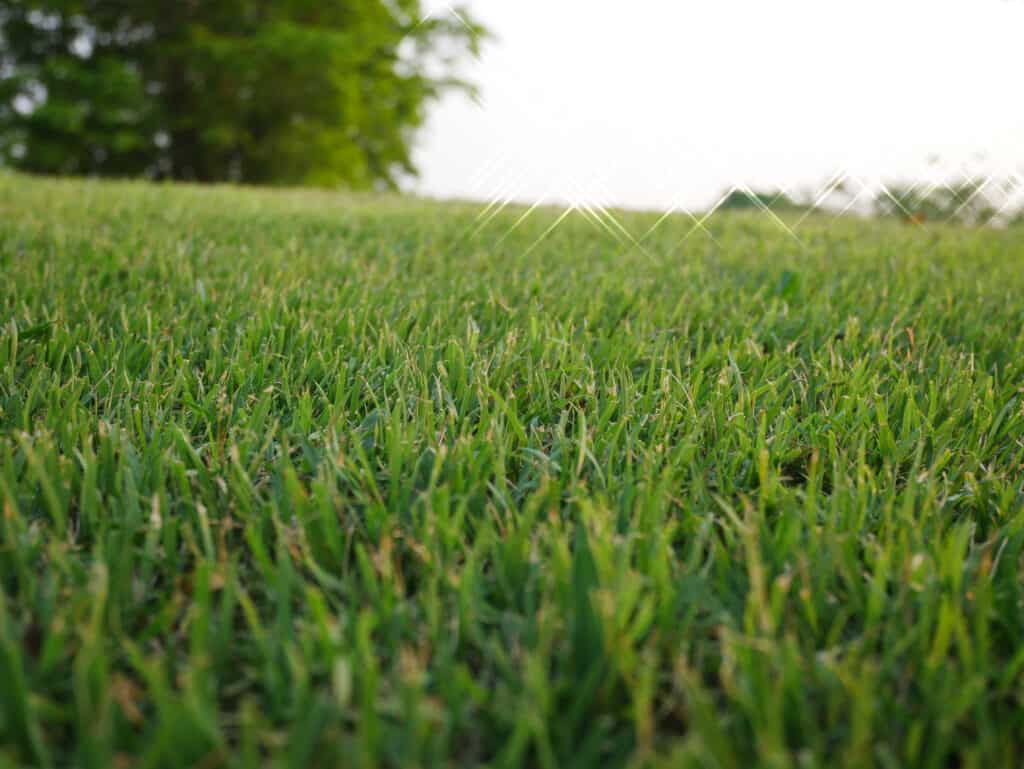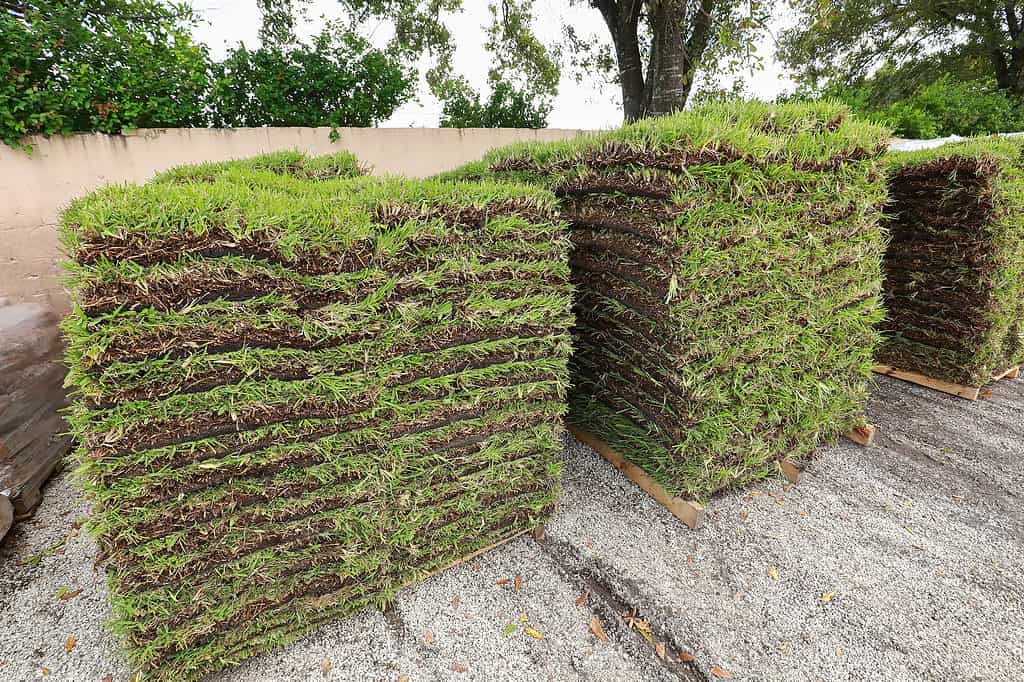There are two main types of grasses: warm-season and cool-season grass. Warm-season grasses grow best during late spring through mid-fall and thrive in full sun. Cool-season grasses grow best from mid-spring into late fall but may die off during summer heat without regular watering. Both Bermuda and St. Augustine grass are warm-season grasses.
| Bermuda Grass | St. Augustine Grass | |
|---|---|---|
| Classification | Cynodon dactylon | Stenotaphrum secundatum |
| Alternative Names | Crabgrass, Bermudagrass, Devil’s grass | Buffalo turf |
| Origin | Europe, Africa, Australia, Asia | Africa, South America, southeast U.S |
| Description | A gray-green color grass with rough edges and possible purple hues. | A dark green grass that is very dense. |
| Uses | It’s commonly used on sports fields and golf courses, as well as yards. | This grass is used in pastures, on ranches, and in yards. |
| Growth Tips | The grass needs full sun and moderate watering. It is fairly drought-tolerant. | The grass needs partial to full sun and very regular watering. |
| Interesting Features | Dogs eat this grass to induce vomiting. | This grass can crowd out weeds in your yard. |

St. Augustine grass can grow equally well while in full sun or partial shade.
©NOPPHARAT539/Shutterstock.com
The Key Differences Between Bermuda Grass and St. Augustine Grass
Bermuda grass and St. Augustine grass look somewhat similar, but the species have quite a few key differences. St. Augustine grows around double the size of Bermuda grass before needing to be mowed. It’s usually kept around 2.5 to 4 inches in length. Bermuda grass is kept much lower at around 1.5 inches.
Bermuda grass doesn’t require as much watering as St. Augustine grass does. In fact, it requires only about half of the water as St. Augustine grass. Bermuda grass does well in full sun but will not grow as successfully in shady spots. On the other hand, St. Augustine grass tolerates both sun and shade.
The two types of grass can be grown in different ways. Bermuda grass is a great option if you’re wanting to put seed down and have time to wait for the grass to grow. Because of this, Bermuda is a cheaper option than St. Augustine grass. St. Augustine grass can only be grown by laying sod. St. Augustine grass also requires yearly maintenance to be de-thatched and must be mowed more often than Bermuda grass.
Classification and Description
Bermuda grass, also known by its scientific name of Cynodon dactylon, and St. Augustine grass, or Stenotaphrum secundatum, are both a part of the Poaceae family. Poaceae includes most of the plants that are known as grasses. It is the fifth-largest plant family.
Bermuda grass is a gray-green color with rough edges. They can also have bits of purple in the stems. In the summer and in full sun, the grass grows quickly and easily. However, it usually turns brown in the winter.
St. Augustine grass is dark green with flat blades and is very dense grass. It’s normally kept much taller than other grass species, often growing up to 4 inches tall before requiring a mow.

Bermuda grass is gray-green with rough edges. Its color may change due to the amount of water it’s receiving.
©Joyjiraporn/Shutterstock.com
Bermuda Grass vs. St. Augustine Grass: Uses
Bermuda grass is commonly used for athletic fields and golf courses. On golf courses, it’s used around tee areas and fairways. This is because it can handle high traffic and has a quick recovery.
In Hinduism, the grass is considered important for worship purposes. It also symbolizes long life. Each year there is a festival for Bermuda grass and it is a part of a few Hindu rituals.
St. Augustine grass is commonly used in residential settings by homeowners. Because it grows so high, it isn’t useful for many commercial settings. Aside from homes, it’s also used in pastures and on ranches where its height makes it great for livestock to feed on.
Bermuda Grass vs. St. Augustine Grass: Origin
Bermuda grass is native to Europe, Africa, Australia, and Asia, but it was introduced to the Americas. It isn’t native to Bermuda, even though the name makes it sound as if it is. In fact, it’s an invasive species in the country, where it’s called “crabgrass”.
St. Augustine grass is native to Africa, South America, and the southeast U.S. It’s also found in many of the southern states and restricted to areas with mild winter temperatures.
Bermuda Grass vs. St. Augustine Grass: How to Grow
Both Bermuda and St. Augustine grass can be easy to grow if you have the right conditions. Bermuda grass requires full sun and average water, as well as mowing once it reaches 1.5 inches tall. St. Augustine grass can grow well in the sun or partial shade, but it does require a lot of water. It also requires de-thatching yearly, while Bermuda grass may only need de-thatching every few years.

St. Augustine grass grows better when planted as sod rather than sown as a seed.
©Jillian Cain Photography/Shutterstock.com
Protections and Conservation
Neither Bermuda nor St. Augustine grass are at conservation risk. They are very popular species of grass in the southeastern U.S. as well as many other countries. It’s unlikely these grasses will need protection in the future because of their popularity. However, the rapid growth of cities and buildings has recently changed areas of grass to pavement. But, as long as there are still backyards and green areas, Bermuda grass and St. Augustine grass should be safe for a long time.
Bermuda Grass vs. St. Augustine Grass: Special Features
Bermuda grass can survive in saline soils with a high salt content that many other types of grass cannot. It’s a great choice for livestock like cattle because it grows quickly and easily. It’s also used by dogs to induce vomiting.
St. Augustine grass is unique because of its ability to crowd out weeds. When it is properly maintained it becomes a thick carpet-like texture that won’t let weeds through.

Dogs will consume Bermuda grass in order to vomit afterward.
©pyzata/Shutterstock.com
Are There Any Other Warm-Season Grasses?

Before you plant grass seed, consider the various types of warm and cool-season grasses available.
©MariuszBlach/iStock via Getty Images
If you think that neither Bermuda grass nor St. Augustine grass will work for you. Try out one of these other warm-season grasses:
- Zoysia grass: This is a drought-tolerant warm-season grass that is popular in the southern United States. It grows quite slowly but has excellent wear tolerance and can tolerate shade better than both Bermuda and St. Augustine grasses.
- Centipede Grass: This slow-growing, low-maintenance warm-season grass is native to China and Japan but is now grown throughout the southeastern US due to its heat resistance and ability to thrive in acidic soils. Its deep roots make it drought-tolerant and slow to recover after damage.
- Bahia grass: This is a coarse, warm-season grass that is native to the southeastern US. It is inexpensive and easy to maintain but has low wear tolerance and will brown during cold spells. It’s also susceptible to many pests and diseases, so regular maintenance is necessary for healthy growth.
- Carpetgrass: This warm-season grass is native to the southeastern US and thrives in wet, acidic soils. It has a low growth rate and produces an even, thick carpet of greenery that can tolerate wear better than other warm-season grasses. Carpetgrass also requires less fertilizer than other varieties.
The photo featured at the top of this post is © aimful/Shutterstock.com
Thank you for reading! Have some feedback for us? Contact the AZ Animals editorial team.







